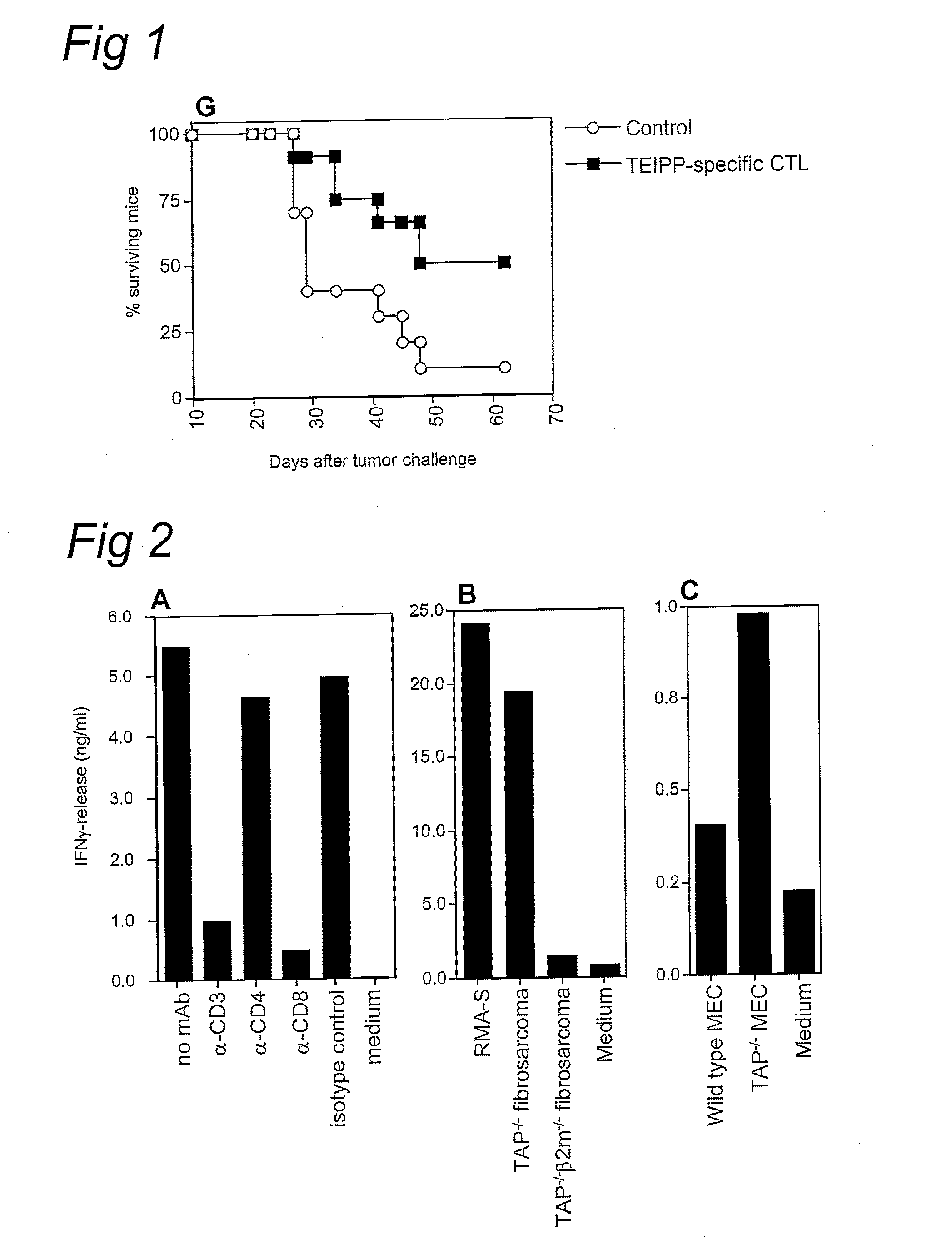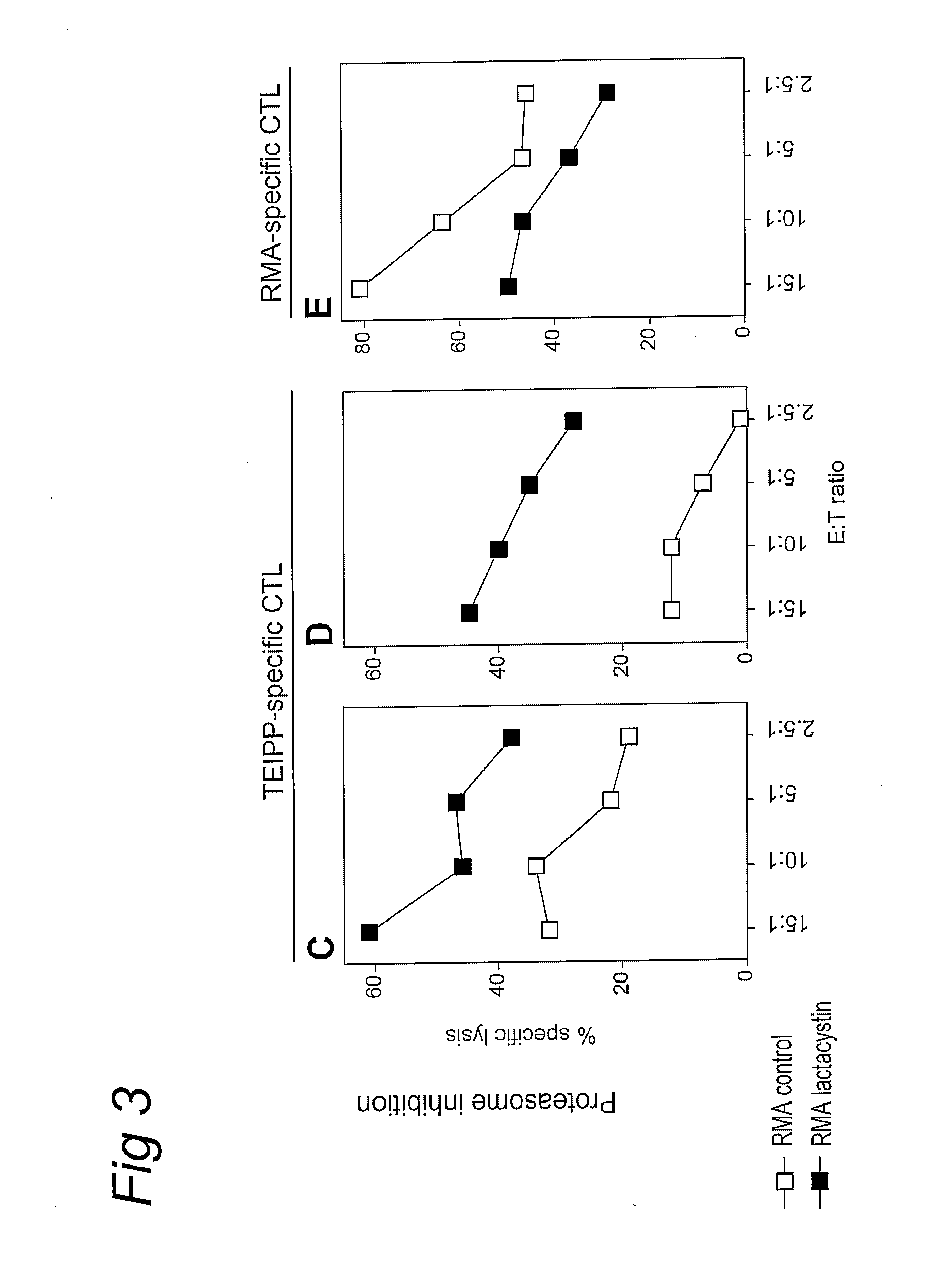Methods for identifying t-cell epitopes associated with impaired peptide processing and applications of the identified epitopes
a technology of t-cell epitopes and peptide processing, applied in the field of medicine, can solve the problems of target cell recognition failure, and achieve the effect of improving the detection efficiency and sensitivity
- Summary
- Abstract
- Description
- Claims
- Application Information
AI Technical Summary
Benefits of technology
Problems solved by technology
Method used
Image
Examples
example 1
Isolation of Clonal T Cell Cultures Capable of Eliminating TAP-Deficient Target Cells In Vitro and In Vivo
[0044]Our previous work pointed at the existence of CD8+ T cells that are capable of reacting against TAP-deficient tumor cells (13). For an in depth analysis of these T cells and their target structure, which we refer to as TEIPP (T cell Epitopes associated with Impaired Peptide Processing), we established long-term T cell cultures from C57BL / 6 (B6) mice by in vivo immunization with TAP-deficient RMA-S.B7-1 tumor cells followed by repeated in vitro restimulation. Polyclonal T cell cultures and clonal T cell lines derived thereof displayed strong cytolytic activity and IFN gamma-release against RMA-S cells and B cell blasts derived from TAP1− / − mice, whereas B cell blasts of wild type mice or β2-microglobulin (β2m)-deficient mice were not recognized (FIG. 1a-f). The requirement of β2m expression suggests that the target structure of TEIPP-specific T-cells comprises MHC class I m...
example 2
TEIPP-Specific T Cells Display a Conventional CD8+ CTL Phenotype and Function
[0046]In view of the paradoxical finding that TEIPP-specific T cells, similar to NK cells, selectively recognize targets that express very low surface levels of MHC class I, we analyzed the expression of several CTL and NK cell markers at the surface of five independently derived T cell clones. All clones displayed a CD3+, CD4−, CD8+, TCRα / β+ phenotype, while generally lacking expression of common NK cell markers such as NK1.1, CD16 and DX-5. (Table I). TEIPP-specific T cells did express CD94 as well as NKG2A, -C and -D, as determined at the mRNA level, while one of the clones was also positive for transcripts of the Ly49-family (Table I). However, CTL clones directed against ‘conventional’ MHC class I-bound peptides similarly expressed these NK-associated markers (Table I), in accordance with data published by others 14. The phenotype of TEIPP-specific T cells was therefore indistinguishable from that of r...
example 3
TEIPP-Specific CTL Detect Deficiencies at Multiple Levels of the MHC Class I Antigen-Processing Pathway in Cells of Diverse Histological Origin
[0047]Thus far, only cells of hematopoietic origin had been tested against TEIPP-specific CTL. However, TEIPP-expression is not restricted to cells of hematopoietic origin, in that a fibrosarcoma tumor cell line of TAP1− / − origin was efficiently recognized, whereas a fibrosarcoma from a TAP1− / −β2m− / − background did not trigger these CTL (FIG. 2b). Likewise, TEIPP-specific CTL recognized immortalized mouse embryo fibroblasts from TAP1− / − origin (FIG. 2c). These data indicated that the TEIPP target structure is expressed by cells of hematopoietic and non-hematopoietic origin, provided that these cells lack TAP-function but do have expression of β2m. Rather unexpectedly, we found that expression of TEIPP also extends to a selection of TAP-expressing cells. For instance, RMA, the TAP-expressing counterpart of RMA-S against which these T cells wer...
PUM
| Property | Measurement | Unit |
|---|---|---|
| Atomic weight | aaaaa | aaaaa |
| Length | aaaaa | aaaaa |
| Acidity | aaaaa | aaaaa |
Abstract
Description
Claims
Application Information
 Login to View More
Login to View More - R&D
- Intellectual Property
- Life Sciences
- Materials
- Tech Scout
- Unparalleled Data Quality
- Higher Quality Content
- 60% Fewer Hallucinations
Browse by: Latest US Patents, China's latest patents, Technical Efficacy Thesaurus, Application Domain, Technology Topic, Popular Technical Reports.
© 2025 PatSnap. All rights reserved.Legal|Privacy policy|Modern Slavery Act Transparency Statement|Sitemap|About US| Contact US: help@patsnap.com



